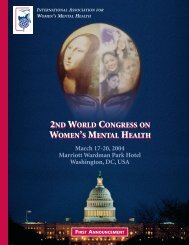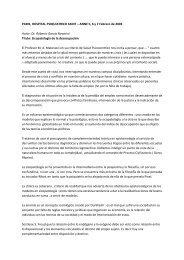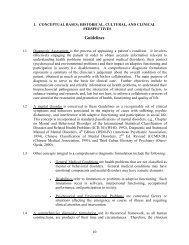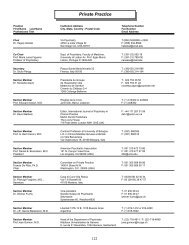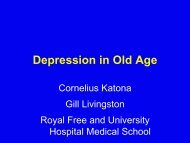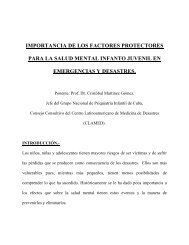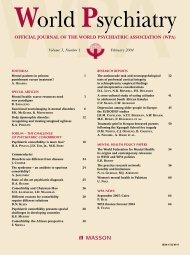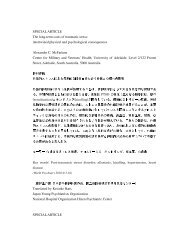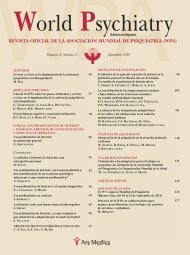ABSTRACTS - World Psychiatric Association
ABSTRACTS - World Psychiatric Association
ABSTRACTS - World Psychiatric Association
Create successful ePaper yourself
Turn your PDF publications into a flip-book with our unique Google optimized e-Paper software.
US20.<br />
VIOLENCE, TRAUMA AND VICTIMIZATION<br />
US20.1.<br />
THE CUMULATIVE LONG-TERM EFFECTS<br />
OF EXPOSURE TO TRAUMATIC EVENTS: THE COST<br />
AND CHALLENGE FOR TREATMENT SERVICES<br />
A.C. McFarlane<br />
University of Adelaide Node, Centre of Military and Veterans<br />
Health, Adelaide, Australia<br />
Increasingly evidence suggests that there is a lifetime cumulative risk<br />
for psychiatric disorders following exposure to repeated traumatic<br />
events. Previously, the focus on post-traumatic stress disorder (PTSD)<br />
has led to an underestimation of the public health significance of<br />
traumatic stress, because the role of these events in the onset of other<br />
disorders such as major depression and substance abuse has been<br />
underappreciated. Epidemiological and long-term cohort studies are<br />
providing valuable insights into how individuals become progressively<br />
sensitized to adverse health outcomes following trauma exposure.<br />
These findings have major implications for understanding the underlying<br />
neurobiological mechanisms that contribute to symptom formation.<br />
The progressive disruption of the homeostatic mechanisms controlling<br />
arousal appears to be a central aetiological process. Furthermore,<br />
it appears that traumatic memories are far more common than<br />
full-blown psychiatric syndrome is following exposure to these events<br />
and represent an important marker of risk. These findings have practical<br />
significance for a number of areas, particularly in the military<br />
and emergency services, highlighting the need to monitor populations<br />
and manage their cumulative stress exposure. To date, the treatment<br />
literature for PTSD has focused on single incident traumas and has<br />
demonstrated the effectiveness of both psychological and pharmacological<br />
interventions. However, the major challenge, which needs to<br />
be confronted in clinical practice, is how to optimally treat individuals<br />
who have a chronic disorder arising from repeated trauma exposure.<br />
In particular, there is a frequent comorbidity of physical disorders,<br />
such as irritable bowel syndrome, fibromyalgia and musculoskeletal<br />
pain, which need to be addressed simultaneously with the<br />
related psychological disorders.<br />
US20.2.<br />
PREVENTION OF POST-TRAUMATIC STRESS<br />
DISORDER BY EARLY TREATMENT<br />
A.Y. Shalev<br />
Department of Psychiatry, Hadassah University Hospital,<br />
Jerusalem, Israel<br />
The effectiveness of early interventions is limited by the accuracy of<br />
case identification, barriers to using mental health services and treatment<br />
efficacy. Several early interventions for post-traumatic stress<br />
disorder (PTSD) have been evaluated. Some have failed altogether<br />
(e.g., debriefing, minor tranquilizers). Others were efficient in small<br />
samples (trauma-focused cognitive behavioral therapy, CBT), and<br />
others (theory-driven pharmacological preventions) are in an experimental<br />
stage. The effectiveness of early interventions for PTSD has<br />
not been studied. The Jerusalem Trauma Outreach and Prevention<br />
Study (J-TOPS) evaluated the accuracy of case identification, the<br />
desirability of early clinical contacts and the relative efficacy of cognitive<br />
behavioral and pharmacological interventions in a comprehensive<br />
sample of 5470 adult survivors of traumatic events. More than<br />
half of those at high risk for developing PTSD declined an offer of<br />
assessment and treatment. Clinical assessment within a month after<br />
the traumatic event optimally identified survivors at risk. CBT with or<br />
without exposure effectively reduced the prevalence of PTSD among<br />
survivors. The effect of a selective serotonin reuptake inhibitor, escitalopram,<br />
did not differ from that of placebo. Early and delayed CBT<br />
had similar long-term effects. Survivors with partial PTSD recovered<br />
as well with or without treatment. Declining early assessment and<br />
treatment were associated with smaller reduction in PTSD symptoms.<br />
Barriers to accepting early interventions should be addressed in<br />
future planning of preventive strategies.<br />
US20.3.<br />
ACCESS TO CARE IN POST-TRAUMATIC STRESS<br />
DISORDER<br />
R.C. Kessler<br />
Department of Health Care Policy, Harvard Medical School,<br />
Boston, MA, USA<br />
We present data on patterns, self-reported reasons for, and sociodemographic<br />
correlates of unmet need for treatment of post-traumatic<br />
stress disorder in the wake of Hurricane Katrina. The data come<br />
from an epidemiological survey carried out in the representative general<br />
population sample of nearly 3000 people who lived in the areas<br />
affected by Katrina in Alabama, Louisiana, and Mississippi in the<br />
United States and who participated in the Hurricane Katrina Community<br />
Advisory Group. The data show that, although structural barriers<br />
were major determinants of unmet need for treatment shortly<br />
after the hurricane, psychological barriers became increasingly<br />
important as objective access to care increased over time. We discuss<br />
innovative strategies needed to document the magnitude of unmet<br />
need for treatment, modifiable determinants of this unmet need, and<br />
the success of intervention efforts to address unmet need in future<br />
disaster situations.<br />
US21.<br />
THE CHALLENGE OF BIPOLAR DEPRESSION<br />
US21.1.<br />
ADVANCES IN THE SHORT-TERM MANAGEMENT<br />
OF BIPOLAR DEPRESSION<br />
J. Calabrese<br />
Case Western Reserve University School of Medicine, Cleveland,<br />
OH, USA<br />
It is now widely recognized that patients with bipolar disorder spend<br />
the majority of their symptomatic lives in the depressed phase of the<br />
illness. Despite the absence of an evidence base, antidepressant<br />
monotherapy continues to be the most commonly prescribed initial<br />
treatment for bipolar disorder. Used this way, the traditional antidepressants<br />
carry a marked risk of inducing mania. Lamotrigine delays<br />
time to re-emergence of mood episodes, but only 2 of 6 studies support<br />
its acute efficacy. Pilot data support the use of divalproex in mood<br />
stabilizer naïve patients with bipolar depression. Like the anticonvulsants,<br />
the atypical antipsychotics were initially studied in mania, but<br />
what separates members of this class is efficacy in bipolar depression.<br />
Olanzapine-fluoxetine combination and, to a lesser extent, olanzapine<br />
have been shown to effectively reduce depressive symptoms. Two<br />
studies of aripiprazole monotherapy failed to show acute efficacy in<br />
bipolar I depression. The results from four acute 8-week bipolar I or II<br />
depression studies (BOLDER I and II, EMBOLDEN I and II) support<br />
the use of quetiapine monotherapy in type I and II presentations,<br />
rapid cycling and non-rapid cycling, anxious and non-anxious pre-<br />
23



